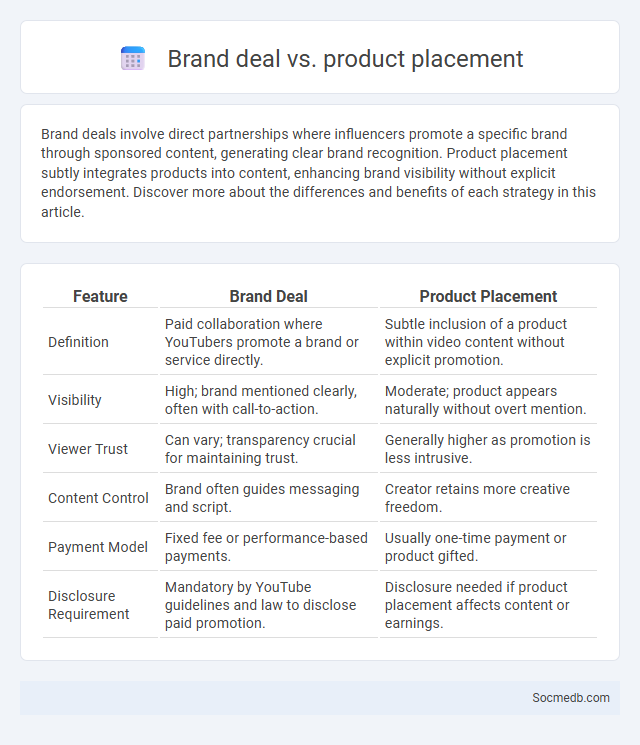
Photo illustration: Brand deal vs Product placement
Brand deals involve direct partnerships where influencers promote a specific brand through sponsored content, generating clear brand recognition. Product placement subtly integrates products into content, enhancing brand visibility without explicit endorsement. Discover more about the differences and benefits of each strategy in this article.
Table of Comparison
| Feature | Brand Deal | Product Placement |
|---|---|---|
| Definition | Paid collaboration where YouTubers promote a brand or service directly. | Subtle inclusion of a product within video content without explicit promotion. |
| Visibility | High; brand mentioned clearly, often with call-to-action. | Moderate; product appears naturally without overt mention. |
| Viewer Trust | Can vary; transparency crucial for maintaining trust. | Generally higher as promotion is less intrusive. |
| Content Control | Brand often guides messaging and script. | Creator retains more creative freedom. |
| Payment Model | Fixed fee or performance-based payments. | Usually one-time payment or product gifted. |
| Disclosure Requirement | Mandatory by YouTube guidelines and law to disclose paid promotion. | Disclosure needed if product placement affects content or earnings. |
Understanding Brand Deals
Understanding brand deals on social media involves recognizing how collaborations between influencers and companies drive targeted marketing campaigns. Your ability to negotiate fair contracts and create authentic content that aligns with the brand's values can significantly enhance engagement and trust. Transparency and compliance with platform guidelines ensure sustained success and attract future partnership opportunities.
What is Product Placement?
Product placement is a marketing strategy where brands integrate their products or services into social media content subtly, enabling organic exposure without overt advertisements. Influencers and creators embed these products within posts, videos, or stories, enhancing brand visibility while maintaining content authenticity. This technique leverages audience trust and engagement to boost brand recognition and drive consumer interest effectively.
Key Differences Between Brand Deals and Product Placement
Brand deals involve direct collaborations where companies pay influencers or creators for promoting their products or services, often with clear contractual agreements. Product placement subtly integrates branded items into content without overt promotion, blending naturally into the narrative to enhance brand visibility. Understanding these key differences helps you choose the best strategy to maximize authenticity and audience engagement.
Types of Brand Deals
Brand deals on social media include sponsored posts, where influencers promote products directly to their audience, and affiliate marketing, which offers commissions based on sales generated through shared links. Collaborative content creation allows brands and influencers to co-produce videos, stories, or posts that resonate authentically with followers. Understanding these types of brand deals helps you maximize marketing effectiveness and build long-term partnerships.
How Product Placement Works
Product placement integrates branded products seamlessly into social media content, enhancing brand visibility without disrupting user experience. Influencers and content creators subtly showcase products within authentic narratives, driving engagement and consumer trust. You can leverage product placement on platforms like Instagram and TikTok to boost brand awareness and influence purchasing decisions effectively.
Pros and Cons of Brand Deals
Brand deals on social media offer influencers significant income opportunities and enhanced brand visibility, leveraging large follower bases for targeted marketing. However, they can risk audience trust due to perceived inauthenticity and may impose creative restrictions that limit genuine content expression. Balancing sponsored content with authentic engagement is essential to maximize long-term influencer-brand relationships.
Advantages and Disadvantages of Product Placement
Product placement in social media leverages targeted advertising by integrating branded products seamlessly into popular content, enhancing brand visibility and consumer engagement. This strategy boosts authenticity and consumer trust while providing influencers with monetization opportunities. However, excessive or poorly executed product placement can lead to audience skepticism, reduce content credibility, and risk regulatory backlash due to inadequate disclosure.
Measuring ROI: Brand Deal vs Product Placement
Measuring ROI in social media marketing involves comparing brand deals and product placements by analyzing engagement metrics such as click-through rates, conversion rates, and sales uplift. Brand deals typically offer higher visibility and direct influence on target audiences, while product placements provide subtler, organic integration within content. Optimal ROI measurement requires tracking both quantitative data like impressions and qualitative impact, including brand sentiment and audience retention.
Choosing the Right Strategy for Your Brand
Selecting the right social media strategy requires identifying your brand's target audience and understanding their platform preferences. Tailoring content types, such as video, infographics, or blog posts, to align with audience engagement patterns maximizes reach and interaction. Analyzing competitors and leveraging analytics tools informs strategy adjustments to enhance brand visibility and conversion rates effectively.
Future Trends in Brand Collaboration and Placement
Future trends in brand collaboration and placement on social media emphasize immersive experiences using augmented reality (AR) and virtual reality (VR) technologies to engage users more interactively. Influencer partnerships will increasingly leverage micro and nano influencers to build authentic connections and drive niche targeting. Data-driven personalization and AI-powered analytics will optimize placement strategies, ensuring higher conversion rates and enhanced audience relevance.
 socmedb.com
socmedb.com